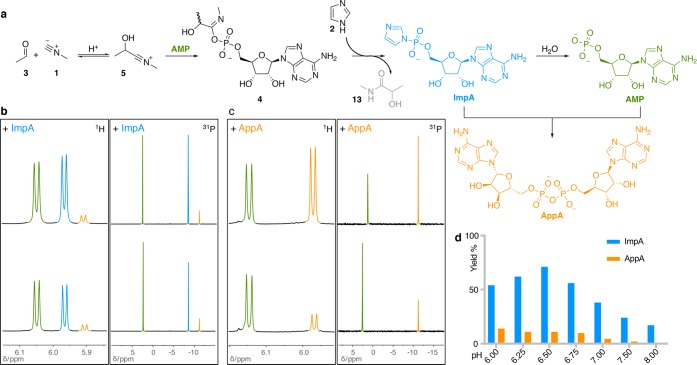Abstract
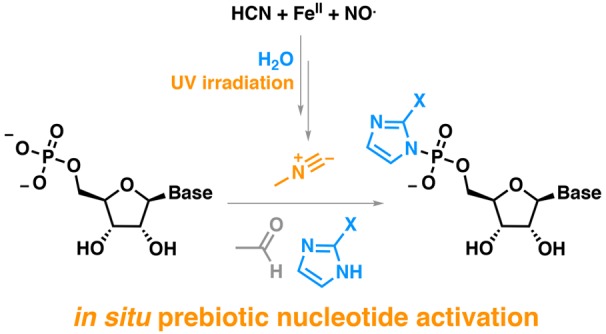
Investigations into the chemical origin of life have recently benefitted from a holistic approach in which possible atmospheric, organic, and inorganic systems chemistries are taken into consideration. In this way, we now report that a selective phosphate activating agent, namely methyl isocyanide, could plausibly have been produced from simple prebiotic feedstocks. We show that methyl isocyanide drives the conversion of nucleoside monophosphates to phosphorimidazolides under potentially prebiotic conditions and in excellent yields for the first time. Importantly, this chemistry allows for repeated reactivation cycles, a property long sought in nonenzymatic oligomerization studies. Further, as the isocyanide is released upon irradiation, the possibility of spatially and temporally controlled activation chemistry is thus raised.
From the pioneering works of Orgel1,2 and Ferris,2,3 through to the most recent breakthroughs of Szostak and co-workers,4,5 nucleoside 5′-phosphorimidazolides have been used as long-lived activated nucleotides for the nonenzymatic oligomerization and templated copying of RNA. Yet, a prebiotically plausible synthesis of such species remains elusive.6,7 Isocyanides are known phosphate activating agents,8 and we have previously described how they could have been involved in a fleeting prebiotic activation of nucleoside monophosphates by Passerini-type chemistry.9 This chemistry requires both isocyanides and aldehydes, and while the latter species arise from the photoredox pathways that lead from HCN to amino acids, lipids, and ribonucleotides,10,11 a prebiotic pathway to the former remains to be found. Herein, following along systems chemistry lines, we describe a potentially prebiotic synthesis of methyl isocyanide 1 and demonstrate its use in the in situ formation of 5′-phosphorimidazolides via interrupted Passerini chemistry in a four-component system.
Incubation of adenosine 5′-monophosphate (AMP) with imidazole 2 (Im), acetaldehyde 3, and methyl isocyanide (pH 6) resulted in the formation of adenosine 5′-phosphorimidazolide (ImpA) in 54% yield after only 30 min (Figure 1, Table S1, and Figure S1a). The reaction could also be performed with other prebiotically relevant aldehydes, such as formaldehyde or glycolaldehyde (41 and 48% yields of ImpA were obtained after 30 min, respectively, data not shown). Screening the reaction with acetaldehyde over a pH range revealed a pH optimum of 6.5 (yield: 71%, Figure 1d and Table S1), presumably reflective of the simultaneous requirements of having imidazole as its free base (pKa of imidazolium ≈ 7.0), dianionic AMP (pKa of AMP monoanion ≈ 6.5), and sufficient acid to protonate acetaldehyde.12 Mechanistically, we speculate that the transient imidoyl phosphate 4 (undetectable by NMR spectroscopy), generated from the reaction of AMP with the nitrilium ion 5, is attacked by imidazole at phosphorus, with the consequent formation of the phosphorimidazolide (Figure 1a).
Figure 1.
Synthesis of ImpA and spiking experiments. (a) Suggested mechanism for the methyl isocyanide-mediated synthesis of ImpA. 1H (left, magnification showing the H–C(1′) region) and 31P (right) NMR spectra confirming the formation of (b) ImpA (100 mM AMP, 400 mM 1, 100 mM 2, 400 mM 3, pH 6.5, 3.5 h) and (c) AppA (100 mM AMP, 400 mM 1, 100 mM 2, 400 mM 3, 20 mM Mg2+, pH 6.5, 72 h; 5-fold dilution before spiking), by spiking with authentic samples (top). (d) Plot of the maximum % yield of ImpA vs pH of the reaction. (green, AMP; blue, ImpA; orange, AppA).
Following its initial formation, and in the absence of a primer–template complex (when polymerization can be expected),4,5 ImpA is progressively hydrolyzed to AMP and thence formation of AMP pyrophosphate (AppA, Figure 2a,b). It is interesting to note that although these outcomes are reflective of the known reactivity of ImpA under these conditions, a connection between 5′,5′-pyrophosphate ribodinucleotides and modern cofactors has been previously suggested.13,14 The other canonical mononucleotides, GMP, CMP, and UMP, displayed analogous behaviors, with ImpN yields ranging from 69 to 75% (Table S1 and Figure S2). Importantly, no modifications occurred to any of the nucleobases, revealing isocyanides to be selective phosphate activating agents.9,15 The requirement for Mg2+ in ribonucleotide polymerization prompted us to investigate the effect of this additive on the synthesis of ImpA. Mg2+ catalysis, as expected, enhanced the rate of both ImpA hydrolysis and AppA production (Figure 2b), but did not affect the initial yield of imidazolide (Table S1).
Figure 2.
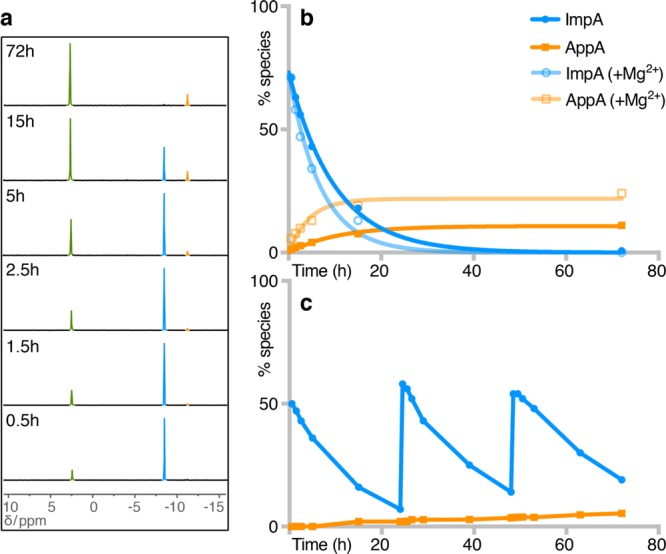
Synthesis and recycling of ImpA. (a) 31P NMR spectra showing ImpA formation and products thereof (100 mM AMP, pH 6.5; reaction times as labeled on each spectrum). (b) Plot of % ImpA and AppA (from a) vs time and effect of Mg2+. (c) Plot of % ImpA and AppA vs time for the (re)cycling of (spent) AMP, by iterative cycles of activation (green, AMP; blue, ImpA; orange, AppA).
A desirable feature in prebiotic nucleotide activation chemistry is the possibility of repeatedly activating the spent monomers that derive from imidazolide hydrolysis to allow for further rounds of polymerization.15 Although it was beyond the scope of this study to investigate polymerization, we sought to establish repeated activation chemistry. Importantly, adding methyl isocyanide in aliquots, followed by intervals in which hydrolysis and pyrophosphate formation served as a proxy for polymerization in a more complex system, resulted in cycles of AMP activation, in which every fresh portion of the activating agent triggered the regeneration of ImpA with comparable efficiency (Figure 2c).
Recently, Szostak and co-workers4,16 have reported the superiority of nucleoside 5′-phosphoro-2-aminoimidazolides (2NH2ImpN) in the nonenzymatic copying of oligoribonucleotides, as a result of more efficient formation of a transient imidazolium bridged dinucleotide. In our system, activation of AMP with methyl isocyanide and acetaldehyde in the presence of 2-aminoimidazole 6 resulted in its conversion to the corresponding 2NH2ImpA at an optimum pH of 7 (Table S1 and Figures S1b and S3). Further optimization resulted in improvements to the production of both ImpA and 2NH2ImpA, with 89% and 76% yields obtained, respectively (Table S1).
For this selective phosphate activation chemistry to have occurred on the primordial Earth, a prebiotic synthesis of methyl isocyanide would have been required. We thus considered its possible formation as a result of metallo-organic chemistry.10,17,18 Iron, as the most abundant transition metal on Earth, probably played a fundamental role in the emergence of life’s building blocks.19 Upon exposure to a primordial atmosphere containing HCN, CO, and NO·, iron would have formed not only stable homoleptic complexes such as [Fe(CN)6]4– (ferrocyanide 7, Figure 3)20 but also mixed ligand complexes with ligands isoelectronic with cyanide of the form [Fe(CN)5L]n−, where L = CO (n = 3) or NO (n = 2).19 Continuing a study initiated by Beck,19,21 we investigated the chemistry of the nitrosyl complex [Fe(CN)5NO]2– (nitroprusside, 8), known, inter alia, to mediate the diazotization of amines.21,22 To determine whether nitroprusside could plausibly have formed under prebiotic conditions on Earth, we considered its possible formation from ferrocyanide and the nitrogen oxides NO·, NO2– (nitrite), and NO3– (nitrate). Lightning and meteorite impacts in the N2-rich primordial atmosphere would have produced NO· (nitric oxide, Figure 3), which could have been directly absorbed into ferrocyanide containing pools, producing nitroprusside in situ. Alternatively, NO2– and NO3– could have accumulated in solution following disproportionation of NO·.23
Figure 3.
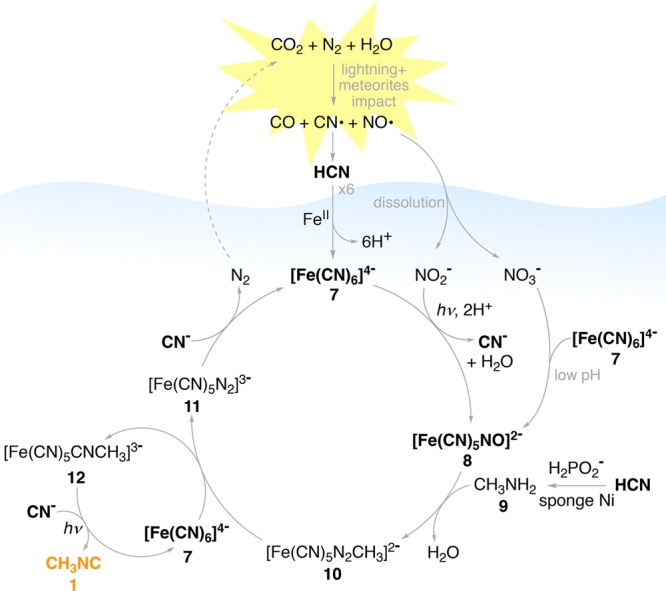
Schematic representation of the systems chemistry network producing methyl isocyanide (1).21 High-energy atmospheric chemistry generates HCN (via CN·), CO and NO·. NO· undergoes various disproportionation reactions upon dissolution,23 providing NO2– and NO3–. HCN is stored in solution as 7, which reacts with NO2– (or NO3–) to provide 8.37 HCN is also a source of CH3NH29, which is diazotized by 8. Alkylation of 7 by 10 gives 12 and 11. Irradiation of 12 in the presence of CN– releases 1 and returns 7; reaction of 11 with CN– returns 7, releasing N2.
Combining literature reports that nitroprusside24 can be formed from NO2– and [Fe(CN)5H2O]3–, and that the latter can be produced by photoaquation of ferrocyanide,25−27 we found that irradiating a mixture of ferrocyanide and NO2– in the pH range 7–9.8 with 365 nm light afforded nitroprusside as the only new FeII complex detectable by 13C NMR spectroscopy (Figure S4a). Importantly, irradiation of the same mixture with 254 nm light also afforded nitroprusside, albeit less efficiently, suggesting that broad band irradiation from the young sun could have supported the formation of this complex.
We next investigated the reactions of nitroprusside with methylamine 9, which would have been delivered to the primordial Earth in comets.28 Alternatively, hydrogenation of HCN to methylamine would have been expected to occur in a geochemical scenario in which iron–nickel meteorites containing schreibersite (Fe,Ni)3P underwent corrosion in HCN-containing pools. In an anoxic environment, corrosion of schreibersite has been shown to give soluble FeII, H2PO2– (hypophosphite), HPO32– (phosphite), and HPO42– (phosphate), while the bulk iron–nickel alloy matrix gives insoluble porous nickel (sponge nickel) or nickel-enriched alloy.29,30 As hypophosphite is known to decompose to H2 and phosphite in the presence of Raney nickel,31 we have recently investigated the hypophosphite-sponge nickel combination as a plausible prebiotic hydrogenation system in keeping with the general geochemical scenario described above. Accordingly, we found that reduction of HCN with hypophosphite and sponge nickel afforded methylamine as the sole organic product, identified by 1H and 13C NMR spectroscopy (Figure S4b,c).
The reaction of methylamine with nitroprusside in the presence of CN– and HPO42– (pH 9.8) proceeded with slow evolution of a gas, presumably N2, indicative of diazotization chemistry. Analysis of the reaction mixture by 1H and 31P NMR spectroscopy confirmed the presence of products expected from the trapping of [Fe(CN)5N2CH3]2–10 by the nucleophiles H2O, CN–, and HPO42–, namely CH3OH (methanol), CH3CN (acetonitrile), and CH3OPO32– (methyl phosphate, Figure 4a,b and Figure S5a), respectively, together with an initially unidentified species. Reasoning that ferrocyanide is also produced under the above reaction conditions (by reaction of cyanide with [Fe(CN)5N2]3–11, Figure 3, or [Fe(CN)5H2O]3–), and realizing that it could act as a nucleophile in its own right, we tentatively assigned the species as the isocyanide complex [Fe(CN)5CNCH3]3–12. This assignment was strengthened by repeating the above reaction with ferrocyanide (1 equiv) present from the outset, which led to an increase in the intensity of the new signal, and unambiguously confirmed by comparison with the 1H NMR spectrum of an authentic standard prepared by addition of methyl isocyanide to a solution of [Fe(CN)5H2O]3– (Figure 4c,e and Figure S6b–d). Although initially concerned by the pH discontinuity between the activation chemistry and methyl isocyanide synthesis, we found that complex 12 could be generated in a pH range between 7 and 9.8, as the diazotization chemistry still proceeds, albeit more slowly, at neutral pH.
Figure 4.
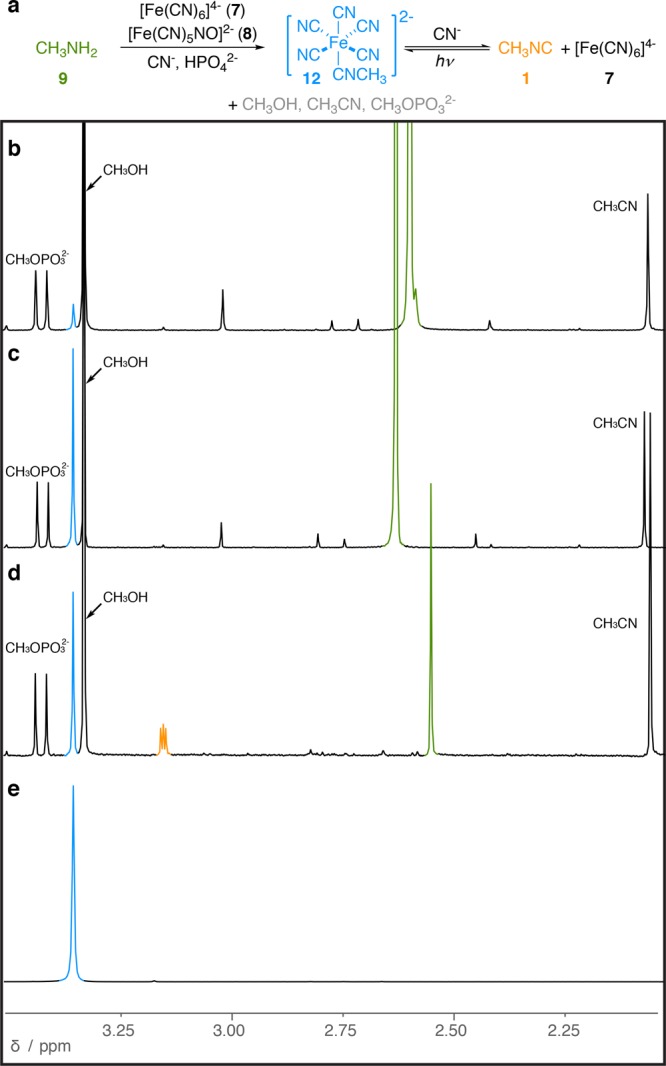
Prebiotic synthesis of methyl isocyanide (1). (a) Schematic representation of the synthesis of 1 via 12. (b) 1H NMR spectrum showing the synthesis of 12 without added 7 (20 h). (c) Same as (b) with 7 present from the start (20 h). (d) 1H NMR spectrum showing the mixture of products obtained following photolysis of prebiotically synthesized 12 (2 h of irradiation). (e) 1H NMR spectrum of synthetically prepared 12 (green, CH3NH2/CH3NH3+; blue, [Fe(CN)5CNCH3]3–; orange, CNCH3).
Mixed ligand isocyanide complexes are known to undergo isocyanide ligand exchange in coordinating organic solvents upon irradiation at 365 nm.32 Irradiation of an aqueous solution of complex 12 at this wavelength, in the presence of excess CN–, provided free methyl isocyanide (yield: 50% after 2 h, Figure S6), clearly identified by its characteristic 1:1:1 triplet at δ 3.16 in the 1H NMR spectrum, and ferrocyanide.33 The remaining materials detectable by 1H NMR spectroscopy were residual complex 12 (41%), and two new complexes, tentatively assigned as cis-[Fe(CN)4(CNCH3)2]2– and trans-[Fe(CN)4(CNCH3)2]2– (signals unassigned, 9%). Further irradiation did not improve the yield of methyl isocyanide, which we attribute to a photostationary equilibrium having been reached.
Next, we sought to link the diazotization chemistry and the photolysis of complex 12, in order to demonstrate that methyl isocyanide could be synthesized in a plausible geochemical setting. Accordingly, a mixture of methylamine, ferrocyanide, and nitroprusside, in the presence of CN– and HPO42– (pH 9.8), was allowed to react for 20 h. The mixture of products obtained was then irradiated for 2 h in the presence of excess CN–. Analysis by 1H NMR spectroscopy showed the expected mixture of products, including methyl isocyanide (Figure 4d).
Interestingly, the byproduct of the imidazolide synthesis described above is 2-hydroxy-N-methylpropanamide 13, the hydrolysis of which would regenerate methylamine and thus feed back into a new cycle for the production of fresh methyl isocyanide. The other product of the hydrolysis would be lactate, a major player in extant and maybe early metabolism.
Overall these findings depict a common plausible scenario in which HCN is not only central to the synthesis of protein, lipid, and RNA building blocks but also drives chemical pathways that ultimately lead to nucleotide activation. In this scenario, methyl isocyanide could have been produced in a ferrocyanide and nitroprusside containing environment upon delivery of methylamine. Pools containing different accumulated materials (possibly at different pH), could have occasionally been linked by streams,34 allowing the methyl isocyanide and nucleotide producing subsystems to mix, thereby enabling nucleotide activation and polymerization chemistry. The lack of high-yielding and prebiotically plausible phosphate activating agents has been a central problem in origin of life research for nearly 60 years, prompting the use of preactivated nucleotide substrates,4,7 synthetic surrogates of ineffective prebiotic reactants,6,35 or prebiotically questionable syntheses of desirable activating agents.36 Here, for the first time, we describe a prebiotically plausible synthesis of methyl isocyanide, a storable and light-releasable activating agent and demonstrate its use in the efficient in situ activation of nucleotide monophosphates.
Acknowledgments
This work was supported by the Medical Research Council (Grant No. MC_UP_A024_1009) and a grant from the Simons Foundation (Grant No. 290362 to J.D.S.). We thank L. Wu and Z. Liu for authentic standards of ImpA and AppA, and all J.D.S. group members for fruitful discussions.
Supporting Information Available
The Supporting Information is available free of charge on the ACS Publications website at DOI: 10.1021/jacs.8b05189.
Materials, methods, compound characterization, supplementary figures and tables (PDF)
Author Contributions
† A.M. and D.A.R. contributed equally.
The authors declare no competing financial interest.
Supplementary Material
References
- Weimann B. J.; Lohrmann R.; Orgel L. E.; Schneider-Bernloehr H.; Sulston J. E. Template-directed synthesis with adenosine-5’-phosphorimidazolide. Science 1968, 161, 387. 10.1126/science.161.3839.387. [DOI] [PubMed] [Google Scholar]
- Ferris J. P.; Hill A. R. Jr; Liu R.; Orgel L. E. Synthesis of long prebiotic oligomers on mineral surfaces. Nature 1996, 381, 59–61. 10.1038/381059a0. [DOI] [PubMed] [Google Scholar]
- Ferris J. P.; Ertem G. Oligomerization of ribonucleotides on montmorillonite: reaction of the 5′-phosphorimidazolide of adenosine. Science 1992, 257, 1387–1389. 10.1126/science.1529338. [DOI] [PubMed] [Google Scholar]
- Li L.; Prywes N.; Tam C. P.; O’Flaherty D. K.; Lelyveld V. S.; Izgu E. C.; Pal A.; Szostak J. W. Enhanced nonenzymatic RNA copying with 2-aminoimidazole activated nucleotides. J. Am. Chem. Soc. 2017, 139, 1810–1813. 10.1021/jacs.6b13148. [DOI] [PMC free article] [PubMed] [Google Scholar]
- Zhang W.; Tam C. P.; Zhou L.; Oh S. S.; Wang J.; Szostak J. W. Structural rationale for the enhanced catalysis of nonenzymatic RNA primer extension by a downstream oligonucleotide. J. Am. Chem. Soc. 2018, 140, 2829–2840. 10.1021/jacs.7b11750. [DOI] [PMC free article] [PubMed] [Google Scholar]
- Joyce G. F.; Orgel L. E. In The RNA World; Gesteland R. F., Cech T. R., Atkins J. F., Eds.; Cold Spring Harbor Laboratory Press, 2006; pp 23–56. [Google Scholar]
- Lohrmann R. Formation of nucleoside 5’-phosphoramidates under potentially prebiological conditions. J. Mol. Evol. 1977, 10, 137–154. 10.1007/BF01751807. [DOI] [PubMed] [Google Scholar]
- Mizung Y.; Kobayashi J. New phosphorylation procedure. Activation of phosphates with cyclohexyl isocyanide. J. Chem. Soc., Chem. Commun. 1974, 997–998. 10.1039/c39740000997. [DOI] [Google Scholar]
- Mullen L. B.; Sutherland J. D. Simultaneous nucleotide activation and synthesis of amino acid amides by a potentially prebiotic multi-component reaction. Angew. Chem., Int. Ed. 2007, 46, 8063–8066. 10.1002/anie.200702870. [DOI] [PubMed] [Google Scholar]
- Patel B. H.; Percivalle C.; Ritson D. J.; Duffy C. D.; Sutherland J. D. Common origins of RNA, protein and lipid precursors in a cyanosulfidic protometabolism. Nat. Chem. 2015, 7, 301–307. 10.1038/nchem.2202. [DOI] [PMC free article] [PubMed] [Google Scholar]
- Ritson D. J.; Sutherland J. D. Synthesis of aldehydic ribonucleotide and amino acid precursors by photoredox chemistry. Angew. Chem., Int. Ed. 2013, 52, 5845–5847. 10.1002/anie.201300321. [DOI] [PMC free article] [PubMed] [Google Scholar]
- Sutherland J. D.; Mullen L. B.; Buchet F. F. Potentially prebiotic Passerini-type reactions of phosphates. Synlett 2008, 2008, 2161–2163. 10.1055/s-2008-1078018. [DOI] [Google Scholar]
- Yarus M. Darwinian behaviour in a cold, sporadically fed pool of ribonucleotides. Astrobiology 2012, 12, 870–883. 10.1089/ast.2012.0860. [DOI] [PMC free article] [PubMed] [Google Scholar]
- Majerfeld I.; Puthenvedu D.; Yarus M. Cross-backbone templating; ribodinucleotides made on poly(C). RNA 2016, 22, 397–407. 10.1261/rna.054866.115. [DOI] [PMC free article] [PubMed] [Google Scholar]
- Szostak J. W. The eightfold path to non-enzymatic RNA replication. J. Syst. Chem. 2012, 3, 2. 10.1186/1759-2208-3-2. [DOI] [Google Scholar]
- Fahrenbach A. C.; Giurgiu C.; Tam C. P.; Li L.; Hongo Y.; Aono M.; Szostak J. W. Common and potentially prebiotic origin for precursors of nucleotide synthesis and activation. J. Am. Chem. Soc. 2017, 139, 8780–8783. 10.1021/jacs.7b01562. [DOI] [PMC free article] [PubMed] [Google Scholar]
- Sutherland J. D. The origin of life – out of the blue. Angew. Chem., Int. Ed. 2016, 55, 104–121. 10.1002/anie.201506585. [DOI] [PubMed] [Google Scholar]
- Powner M. W.; Sutherland J. D. Prebiotic chemistry: a new modus operandi. Philos. Trans. R. Soc., B 2011, 366, 2870–2877. 10.1098/rstb.2011.0134. [DOI] [PMC free article] [PubMed] [Google Scholar]
- Beck M.Prebiotic coordination chemistry: the potential role of transition-metal complexes in the chemical evolution. NASA TM-75381, 1979, originally published in Kemiai Közlemenyek 1978, 50, 223–240. [Google Scholar]
- Keefe A. D.; Miller S. L. Was ferrocyanide a prebiotic reagent?. Origins Life Evol. Biospheres 1996, 26, 111–129. 10.1007/BF01809851. [DOI] [PubMed] [Google Scholar]
- Dózsa L.; Kormos V.; Beck M. T. Kinetics of the reaction of pentacyanonitrosylferrate(II) with aliphatic amines. Inorg. Chim. Acta 1984, 82, 69–74. 10.1016/S0020-1693(00)82540-2. [DOI] [Google Scholar]
- Maltz H.; Grant M. A.; Navaroli M. C. Reaction of nitroprusside with amines. J. Org. Chem. 1971, 36, 363–364. 10.1021/jo00801a031. [DOI] [Google Scholar]
- Mancinelli R. L.; McKay C. The evolution of nitrogen cycling. Origins Life Evol. Biospheres 1988, 18, 311–325. 10.1007/BF01808213. [DOI] [PubMed] [Google Scholar]
- Swinehart J. H.; Rock P. A. The equilibrium and kinetic properties of the aqueous hydroxide-nitroprusside system. Inorg. Chem. 1966, 5, 573–576. 10.1021/ic50038a017. [DOI] [Google Scholar]
- Stein G. Photochemistry of the ferrocyanide ion in aqueous solution: hydrated electron formation and aquation. Isr. J. Chem. 1970, 8, 691–697. 10.1002/ijch.197000084. [DOI] [Google Scholar]
- Shirom M.; Stein G. Excited state chemistry of the ferrocyanide ion in aqueous solution. II. Photoaquation. J. Chem. Phys. 1971, 55, 3379–3382. 10.1063/1.1676588. [DOI] [Google Scholar]
- Gáspár V.; Beck M. T. Kinetics of the photoaquation of hexacyanoferrate(II) ion. Polyhedron 1983, 2, 387–391. 10.1016/S0277-5387(00)83934-0. [DOI] [Google Scholar]
- Aponte J. C.; Elsila J. E.; Glavin D. P.; Milam S. N.; Charnley S. B.; Dworkin J. P. Pathways to meteoritic glycine and methylamine. ACS Earth Space Chem. 2017, 1, 3–13. 10.1021/acsearthspacechem.6b00014. [DOI] [PMC free article] [PubMed] [Google Scholar]
- Pasek M. A.; Harnmeijer J. P.; Buick R.; Gull M.; Atlas A. Evidence for reactive reduced phosphorus species in the early Archean ocean. Proc. Natl. Acad. Sci. U. S. A. 2013, 110, 10089–10094. 10.1073/pnas.1303904110. [DOI] [PMC free article] [PubMed] [Google Scholar]
- Tackett S. L.; Meyer W. M. Jr.; Pany F. G.; Moore C. B. Electrolytic dissolution of iron meteorites. Science 1966, 153, 877–880. 10.1126/science.153.3738.877. [DOI] [PubMed] [Google Scholar]
- Backeberg O. G.; Staskun B. A novel reduction of nitriles to aldehydes. J. Chem. Soc. 1962, 3961–3963. 10.1039/jr9620003961. [DOI] [Google Scholar]
- Costanzo L. L.; Giuffrida S.; De Guidi G.; Condorelli G. Photochemical and thermal behaviour of isocyanide complexes. V*. Photolysis of Fe(CNCH3)4(CN)2 in acetonitrile. J. Organomet. Chem. 1986, 315, 73–77. 10.1016/0022-328X(86)80412-0. [DOI] [Google Scholar]
- The full wavelength dependence of this ligand exchange reaction has not been studied, but as expected, the release of free methyl isocyanide did not occur upon irradiation at 254 nm.
- Ritson D. J.; Battilocchio C.; Ley S. V.; Sutherland J. D. Mimicking the surface and prebiotic chemistry of early Earth using flow chemistry. Nat. Commun. 2018, 9, 1821. 10.1038/s41467-018-04147-2. [DOI] [PMC free article] [PubMed] [Google Scholar]
- Jauker M.; Griesser H.; Richert C. Copying of RNA sequences without pre-activation. Angew. Chem., Int. Ed. 2015, 54, 14559–14563. 10.1002/anie.201506592. [DOI] [PMC free article] [PubMed] [Google Scholar]
- During the preparation of this manuscript, a report on the purportedly prebiotic synthesis of nucleoside 5′- phosphorimidazolides from 1 M sodium cyanide and 1 M sodium hypochlorite (bleach) was published:Yi R.; Hongo Y.; Fahrenbach A. C. Synthesis of imidazole-activated ribonucleotides using cyanogen chloride. Chem. Commun. 2018, 54, 511–514. 10.1039/C7CC08489G. [DOI] [PubMed] [Google Scholar]
- Butler A. R.; Glidewell C.; Hyde A. R.; McGinnis J. Nitrogen-15 and carbon-13 NMR study of Roussin salts and esters and of pentacyanoferrate complexes. Inorg. Chem. 1985, 24, 2931–2934. 10.1021/ic00213a012. [DOI] [Google Scholar]
Associated Data
This section collects any data citations, data availability statements, or supplementary materials included in this article.



